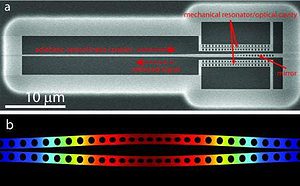For many quantum mechanics is very hard to comprehend because so many of its insights are extremely bizarre (see spooky action at a distance or quantum entanglement) and counter-intuitive (for instance wave-particle duality, which is the idea that all things have both a wave- and particle-like nature). For many years scientists vacuum was synonymous with void. Once quantum mechanics theories that discuss very small things like atoms and subatomic particles were proposed at the beginning of the last century, it soon became clear that vacuum was far from being empty, nor still.
The latter insight has helped scientists a great deal calibrate their instruments when observing the Universe. You see, even in vacuum there’s noise, albeit imperceptible in the form tiny quantum fluctuations. Recently, a team of researchers at the California Institute of Technology (Caltech) have engineered a system that produced, what’s referred to as, “squeezed light” – a special type of light with fewer fluctuations that those found in vacuum which is useful for making precise measurements at lower power levels than are required when using normal light.
Researcher into “squeezed light” and its potential benefits can be traced back to more than 30 years ago, when Caltech’s superstar physics department comprised of Kip Thorne, Caltech’s Richard P. Feynman Professor of Theoretical Physics, Emeritus, and physicist Carlton Caves first proposed that squeezed light would enable scientists to build more sensitive detectors that could make more precise measurements. A decade later, colleagues at Caltech conducted some of the first experiments using squeezed light, which relied on so-called nonlinear materials, which have unusual optical properties.
‘Quiet’ light

(a) SEM image of the silicon micromechanical resonator used to generate squeezed light. Light is coupled into the device using a narrow waveguide and reflects off a back mirror formed by a linear array of etched holes. Upon reflection, the light interacts with a pair of double-nanobeams (micromechanical resonator/optical cavity), which are deflected in a way that tends to cancel fluctuations in the light. (b) Numerical model of the differential in-plane motion of the nanobeams.
Credit: Caltech/Amir Safavi-Naeini, Simon Groeblacher, and Jeff Hill
– See more at: http://www.caltech.edu/content/caltech-team-produces-squeezed-light-using-silicon-micromechanical-system#sthash.Xfz0rGwg.dpuf
These materials are very difficult to manufacture and come-by, however. This latest Caltech research into squeezed light, led by Oskar Painter, a professor of applied physics at Caltech and the senior author on a paper that describes the system, seeks to address this issue. Their system produces the same fabled squeezed light, yet instead of complicated materials, it relies on the old-fashioned and abundant silicone.
“This system should enable a new set of precision microsensors capable of beating standard limits set by quantum mechanics,” says Oskar Painter. “Our experiment brings together, in a tiny microchip package, many aspects of work that has been done in quantum optics and precision measurement over the last 40 years.” –
Instead of using complicated materials of unique optical characteristics, the researchers employed a special design.
“We work with a material that’s very plain in terms of its optical properties,” says Amir Safavi-Naeini (PhD ’13), a graduate student in Painter’s group and one of three lead authors on the new paper. “We make it special by engineering or punching holes into it, making these mechanical structures that respond to light in a very novel way. Of course, silicon is also a material that is technologically very amenable to fabrication and integration, enabling a great many applications in electronics.”
In this new system, a waveguide feeds laser light into a cavity created by two tiny silicon beams. Once there, the light bounces back and forth a bit thanks to the engineered holes, which effectively turn the beams into mirrors. When photons—particles of light—strike the beams, they cause the beams to vibrate. And the particulate nature of the light introduces quantum fluctuations that affect those vibrations. This noise interferes with measurements, which means more power needs to be dedicated to the light in order to overcome it and make precise measurements, this comes with numerous drawbacks however.
According to the researchers, here lies the key – the spooky wave-particle duality. You may have heard of noise canceling headphones, which when strapped and turned on, will cancel any kind of ambient noise around you. The new system more or less works in the same way by canceling noise through interference. Namely, in our case light and beams interact strongly with each other—so strongly, in fact, that the beams impart the quantum fluctuations they experience back on the light.
“This is a demonstration of what quantum mechanics really says: Light is neither a particle nor a wave; you need both explanations to understand this experiment,” says Safavi-Naeini. “You need the particle nature of light to explain these quantum fluctuations, and you need the wave nature of light to understand this interference.”
“This new way of ‘squeezing light’ in a silicon micro-device may provide new, significant applications in sensor technology,” said Siu Au Lee, program officer at the National Science Foundation, which provided support for the work through the Institute for Quantum Information and Matter, a Physics Frontier Center. “For decades, NSF’s Physics Division has been supporting basic research in quantum optics, precision measurements and nanotechnology that laid the foundation for today’s accomplishments.”
The findings were described in the journal Nature.









